
* The Su-27 was created in response to the development of new Western aircraft, particularly the McDonnell Douglas F-15 Eagle. Development of the Su-27 proved difficult, but in the end the Red Air Force obtained an superlative combat aircraft.
* In 1969, the United States Air Force (USAF) selected the McDonnell Douglas F-15 as the winner of the service's "Fighter Experimental (FX)" program. Faced with a formidable new American threat, the Soviet government immediately issued a request for a new fighter of their own to match the F-15, under the designation "Perspektivnyi Frontovi Istrebitel (PFI / Prospective Frontal Fighter)". The program was also apparently referred to as the "anti-F-15".
The PFI was specified as a long-range interceptor to replace older aircraft of that category, such as the Tupolev Tu-128 "Fiddler", the Sukhoi Su-15 "Flagon", and the Yak-28P "Firebar". As a secondary requirement, it was to be used as an escort for long-range strike aircraft such as the Su-24 "Fencer"; or as a long-range intruder to attack Western air assets such as tankers or airborne warning & control systems (AWACS) deep in hostile territory.
The PFI requirements specified an agile aircraft with a top speed of 1,450 KPH (783 knots); a combat radius of 1,700 kilometers (915 nautical miles) at high altitude and 500 kilometers (270 nautical miles) at low altitude; and an operational ceiling of 18,300 meters (60,000 feet). The PFI was to be able to operate from what the Red Air Force (VVS / Voyenno Vozdushniye Sily) called a "Third Class Airfield", with a runway length of 1,200 meters (3,940 feet).
The Mikoyan and Sukhoi design bureaus (OKBs) both began work on the PFI specification. The Yakovlev OKB also initiated work on the requirement, but dropped out to pursue the Yak-41 vertical take-off fighter. The Sukhoi design team was led by Yevgeny Ivanov and his deputy, Oleg Samolovich, with inputs from OKB Director General Pavel Sukhoi. Guided by aerodynamic data supplied by the TsAGI (Tsentral'nyi Aerogidrodynamichesky Institut / Central Aerodynamic & Hydrodynamic Research Institute), both the Sukhoi and MiG OKBs designed aircraft with a twin-finned, high-winged, tailed-delta configuration, and using a new armament and fire-control system being implemented by other design bureaus. The main armament was to be the "K-25" air-to-air missile (AAM), which was apparently along the lines of the US Sparrow, but which in fact would never reach production.
It soon became obvious that the agility and range requirements of the PFI specification were incompatible, and so, under the urging of MiG OKB Director General Artem Mikoyan, the PFI specification was split into "Logiky PFI (LPFI / Lightweight PFI)" and "Tyazholyi PFI (TPFI / Heavy PFI)" specifications. This also mirrored American thinking, since the US Air Force had followed their F-15 program with a relatively low-cost "lightweight fighter" effort that would result in the F-16 Fighting Falcon.
One of the designs the Mikoyan OKB had investigated proved suitable for the LPFI specification, and became the Mikoyan MiG-29. The Sukhoi design proved a fit for the HPFI specification, and was designated "T10", since it was the tenth delta ("Teugoinyi / Triangular") winged aircraft designed by the Sukhoi OKB.
The T10 was a big aircraft, with large volume for carrying fuel and systems, and its elegantly-curved wing was blended into the fuselage to improve lift. Long leading-edge root extensions (LERX) were fitted to allow good handling at high angles of attack. The twin fins provided maximum control authority and directional stability. The T10 featured twin engines, initially Saturn-Lyulka "AL-21F-3" afterburning bypass jets providing 109.9 kN (11,200 kgp / 24,700 lbf) afterburning thrust each, with the intakes under the wing roots.
The first T10, designated "T10-1" or "Blue 10", flew on 10 May 1977, with Sukhoi's chief test pilot, General Vladimir Ilyushin, at the controls. Vladimir Ilyushin was the son of Sergei Ilyushin, who had founded the Ilyushin OKB, Vladimir being a well-known and internationally respected figure in his own right. The T10 was the 143rd aircraft he had piloted, including almost every Soviet type and even the B-25 Mitchell, the Cessna A-37, and the Northrop F-5E. Ilyushin was extremely pleased with the T10.
Blue 10 was immediately spotted by a US reconnaissance satellite, with NATO giving the new type the provisional name of "Ram-K", since Western intelligence did not know the name for the secret Zhukovsky flight center and simply referred to it as "Ramenskoye", a nearby town. Some over-imaginative analysts thought it had variable geometry wings, and a few years would pass before that myth would be discarded. Other analysts suggested that it was a copy of a Western aircraft, much to the irritation of the aircraft's designers. To be sure, the Ram-K had features similar to those of Western fighters that had preceded it, but those Western fighters in some cases had features of various Soviet fighters that had preceded them in turn. In reality, similar aerodynamic and mission requirements tended to lead to similar design solutions, and of course aircraft designers had no reason to turn up their noses at the good ideas of others.
To an extent, however, the "copycat" accusation wasn't based completely on snobbery, since the USSR, particularly in Stalin's day, pragmatically did not hesitate to copy or steal useful foreign technologies. In fact, the MiG and Sukhoi OKBs occasionally accused each other of copying as well, though similarities between their respective efforts were often inevitable since they were working from the same TsAGI aerodynamic recommendations.
The second T10 prototype, the "T10-2", was lost on 7 May 1978, with the pilot, Yevgeny Solovyev, killed while ejecting. A total of four prototypes was built by the Sukhoi OKB in the bureau's workshops, while five more were built at the state factory at Komsomolsk between 1980 and 1982. The state factory also provided subassemblies for the four prototypes developed at the Sukhoi workshops. As Western intelligence learned more about the aircraft, it was given the NATO reporting name of "Flanker-A".
The prototypes varied in details, with two of those developed at the bureau workshops featuring production Lyulka-Saturn "AL-31" afterburning bypass jet engines. Two more prototypes were under construction when the decision was made to redesign the aircraft, as tests showed the T10 prototypes were not meeting performance specifications. As the T10 stood, it was no match for the American F-15.
* The redesigned aircraft was designated the "T10S", with the "S" optimistically standing for "Series". Roughly ten T10S prototypes were produced, with some of them built new and some rebuilt from T10 prototypes. Initial T10S prototypes were similar to the T10, with incremental changes progressing through the series to the final production configuration.
The development effort continued to have more than its share of troubles. The first T10S prototype, the "T10S-1", rebuilt from the "T10-7", performed its initial flight on 20 April 1981 with Vladimir Ilyushin as pilot but was lost due to a fuel system problem, Ilyushin ejecting safely.
The second prototype, the "T10S-2", rebuilt from the T10-12, broke up in flight on 23 December 1981, killing its pilot, Alexander Komarov. Another prototype, the "T10S-7", was wrecked when the pilot, Nikolai Sadovnikov, tried only too successfully to duplicate the fatal last flight of the T10S-2, but Sadovnikov skillfully managed to get the aircraft back down on the ground even though it had lost much of its left wing. It turned out that the two accidents were caused by defective leading-edge flaps that had broken away. The flaps were promptly redesigned.
After these nasty teething problems were resolved, the test pilots were wildly enthusiastic about the performance and handling of the T10S, particularly in comparison to the T10. Unfortunately, after the flight problems of the aircraft were generally resolved, manufacturing problems remained. The production aircraft, designated "Su-27", only began to enter service in small numbers in 1986. NATO gave the production aircraft the reporting name "Flanker-B". The initial production single-seater was also referred to as the "Su-27S", and this is the preferred usage in this document, allowing the designation "Su-27" to refer to any or all variants in the family of aircraft. However, it should be remembered that the designation of "Su-27" is perfectly valid for the Su-27S, and probably in wider usage.
* While the manufacturing problems were being resolved, some of the prototypes were being used to set flight records. The "P-42" was converted from the T10S-3 by stripping it of all unnecessary equipment, and was used to successfully challenge records held by the similarly stripped-down F-15 "Streak Eagle". The flights were performed by Sukhoi test pilots Sadovnikov and Viktor Pugachev. One of the flights set a record climb to 15,000 meters (49,200 feet) in 70.33 seconds, breaking the Streak Eagle's record by seven seconds.
That was cause for satisfaction, given the rocky path of the aircraft's development, and encouraged believers that the effort would pay off after all. Another prototype, the "T10S-10", was stripped down and modified to challenge the 500-kilometer (270 nautical mile) closed circuit speed record, but it appears it was never actually used in such an attempt.
BACK_TO_TOP* The production Su-27S clearly retained much of the look of the original T10, but the changes were visible and obvious. The most apparent change was the adoption of a larger wing that featured straight edges, replacing the curved wing of the T10.
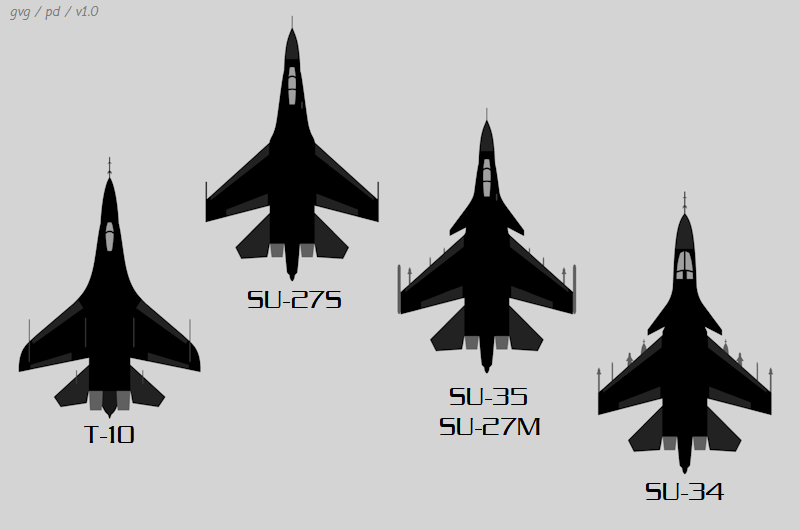
Other visible changes included:
Of course, the Su-27S had armament and operational avionics systems, including radar, countermeasures, radios, navigation systems, and IFF (identification friend or foe) transponder. Armament included:
In mature production aircraft, the wingtip rails could be removed and replaced with Sorbtsiya electronic countermeasures (ECM) pods, and some aircraft had three stores pylons on each wing, along with the wingtip rails.
An OEPS-27 infrared track-&-search (IRST) sensor was fitted just in front of the cockpit along with a laser rangefinder, and the nose accommodated the Tikhomirov "N001 Mech (Sword)" radar system. The N001 was a pulse-doppler radar with excellent range and look-down / shoot-down capability, but was mostly or entirely designed for air-to-air combat, and could only target a single adversary at a time. It was basically an improved version of the Phazotron N019 radar used on the MiG-29, and had an old-fashioned mechanically-steered dish antenna.
The limitations of the radar meant that the Su-27S was more reliant on ground control or comparable direction from an airborne warning and control system (AWACS) aircraft, with the fighter receiving directions over a radio datalink. In later production Su-27S machines, the tail stinger extension accommodated the tail radome for the SPO-15 (L-006) Beryoza ELINT system, as well 32 three-shot chaff-flare dispensers. The stinger may have also stored a jammer system.
The Su-27S was built mostly of aircraft aluminum alloy, with some stainless steel and titanium. Each wing had a single large "flaperon" in the rear and a two-piece leading-edge flap. The tailplanes were all-moving, while the tailfins had one-piece rudders. Flight controls were hydraulically operated, with some pneumatic backup systems. The pilot flew the aircraft through a quadruple-redundant analog electronic fly-by-wire (FBW) flight control system. The nosewheel retracted forward, as did the main gear, rotating 90 degrees to lie flat in the wing roots. All three gear assemblies had single wheels.
The pilot sat high with an outstanding all-round view on a Zvezda K-36DM zero-zero (zero speed, zero altitude) ejection seat, under a clamshell canopy that hinged on the rear. The original prototypes, incidentally, had featured a rear-sliding canopy. The ejection seat included a NAZ-8 survival pack, with rescue radio / beacon, rations, flares, medical supplies, and an inflatable raft. The cockpit controls were far from leading-edge, the pilot obtaining information through a "steam gauge" set of indicators. There was, however, a small head-up display (HUD) and there were limited controls on the stick. One nice feature was that the pilot had a Schel 3U helmet-mounted sight, a feature that wouldn't become common in Western aircraft for some time.
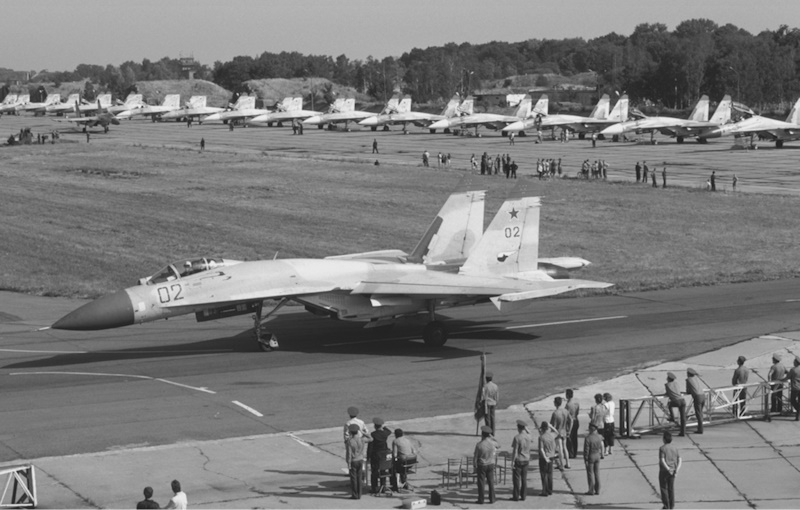
The Su-27S was powered by twin Saturn-Lyulka "AL-31F" production afterburning bypass jets, with 122.8 kN (12,515 kgp / 27,600 lbf) afterburning thrust each. The AL-31F was very reliable by Soviet engine standards, with a good time between overhaul of 1,000 hours, and the airframe allowed easy access to the engines. The engine was very resistant to stalls and flameouts, an important factor in a maneuverable aircraft where airflow could vary drastically. The inlets were variable, with a ramp in the top.
___________________________________________________________________
SU-27S "FLANKER" (LATE PRODUCTION):
___________________________________________________________________
wingspan:
14.7 meters (48 feet 3 inches)
wing area:
46.5 sq_meters (500.54 sq_feet)
length:
21.9 meters (72 feet)
height:
5.93 meters (19 feet 6 inches)
empty weight:
16,380 kilograms (36,100 pounds)
max loaded weight:
28,300 kilograms (62,400 pounds)
maximum speed:
2,500 KPH (1,550 MPH / 1,350 KT)
service ceiling:
18,000 meters (59,000 feet)
combat radius:
1,500 kilometers (930 MI / 810 NMI)
___________________________________________________________________
The new Sukhoi fighter began to perform mock intercepts of Western aircraft over the Barents Sea in early 1987, though at first Su-27s kept their distance. However, Norwegian F-16 pilots soon managed to get pictures of the type, and in September 1987 the crew of a Norwegian P-3 Orion ocean-patrol aircraft got a much closer view than they liked when an Su-27S clumsily clipped one of the P-3's propellers with its tail. Fortunately, both aircraft made it safely back home.
The Su-27S made its formal introduction to the West at the 1989 Paris Air Show, when Viktor Pugachev ran the aircraft through the now-famous "Cobra" maneuver, lifting the fighter to an angle of attack of over 90 degrees to its line of flight, causing abrupt deceleration until it nosed back down. The Cobra maneuver was apparently invented by another Sukhoi test pilot, Valeriy Menitsky, as a flight-test exercise -- but it became associated with Pugachev, it seems with his encouragement, and is also often called the "Pugachev maneuver" or "Pugachev Cobra". It is argued that the Cobra maneuver has much combat utility, but it is undeniably a spectacular airshow trick.
Western observers were still shocked, since there were few or no Western aircraft that could perform the Cobra maneuver, and even though it may have been nothing more than a stunt, it demonstrated that the Su-27S was remarkably agile and very strongly built. Observers reasoned that an Su-27S fully loaded for combat operations would not have the same level of agility as one flying "clean" in airshow -- but the agility of the Su-27S was still impressive given its size, all the more so because the Su-27S was not a "dynamically unstable" design. Western designers have chosen to build maneuverable aircraft by designing them to be aerodynamically unstable, and then using advanced control systems to keep them flying right. Russian designers, preferring reliability and with less access to sophisticated avionics systems, opted for building a stable design and tweaking it for maximum maneuverability.
The Su-27S was, as mentioned, originally developed as a long-range "fighter interceptor" for the VVS and the Soviet national air defense command (PVO / Protivo Vozdushniye Oborony), and was largely optimized for that role. Typical air-defense warload could be six "beyond visual range (BVR)" AAMs and two or four short-range "dogfighting" AAMs.
While the aircraft's standard BVR missile, the "R-27" -- NATO reporting name "AA-10 Alamo" -- was regarded as inferior to the US AIM-120 AMRAAM, the standard dogfighting missile, the Vympel "R-73 (NATO AA-11 Archer)", was regarded as a pioneer in its class. The R-73 had an "off-boresight" engagement capability, with the pilot cueing it to a target not directly in front of the aircraft with the helmet-mounted sight. The helmet-mounted sight could also be used to cue the IRST and laser rangefinder. While the US was developing AMRAAM at great expense and difficulty, the Soviets moved ahead with the R-73, and the Americans had to later play "catch-up" with the AIM-9X Sidewinder AAM.
The electronics systems of the Su-27S were less sophisticated than those of equivalent Western aircraft, and there were questions about their reliability -- but the IRST had good tracking capability, and the radar had excellent range. However, the radar did not have the intelligent processing of Western counterparts. In the air-defense role, the Su-27S was designed to operate in conjunction with ground or air-based air-defense networks, a traditional Soviet practice, and the Su-27S datalink allowed it to perform intercepts "passively", guided to the target by controllers without using its own radar.
Although the reliability of the aircraft's electronics might have been uncertain, Russian partisans like to mock Western aircraft for their delicacy and inability to operate off of rough airstrips. The rugged Su-27S was designed for such an environment, and had no difficulty with it.
The large size of the Su-27S made it potentially useful as a strike aircraft, able to carry a wide range of munitions -- but strike was a secondary mission for the basic Su-27, and in the late 1980s most or all Su-27S machines were modified in accordance with the "Conventional Forces in Europe (CFE)" arms limitation treaty to eliminate whatever air-to-ground capabilities they had. These "pure air combat" machines were sometimes been referred to under the designation of "T10P" or "Su-27P". Even ignoring that somewhat artificial restriction, a reasonable judgement of the Su-27S would have placed it as superlative in its role as a fighter-interceptor, but probably not the equal of the F-15 as a multi-role aircraft.
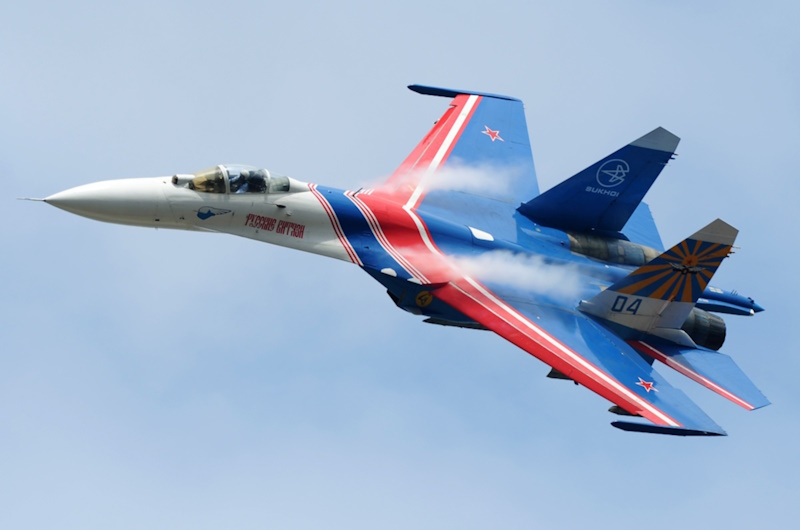
* The Su-27 became the mount of the "Russian Knights" flight demonstration team, with their aircraft painted in a colorful airshow scheme. By the way, the Su-27S had no formal name. Sukhoi officials referred to it as the "Azure Lighting", but it seems it was generally called the "Crane", for its bent-necked appearance in flight. Some sources claimed that Russian personnel occasionally even referred to it by its NATO reporting name, "Flanker".
BACK_TO_TOP* The Su-27S was a big and complicated aircraft that demanded much of its pilots, and so during T10 and T10S development the Sukhoi OKB also worked on a two-seat operational conversion trainer version. Due to the development difficulties discussed above, work on the two-seat version had to be set aside until the single-seat version was in production; the first two-seat T10U prototype did not fly until March 1985, entering production and service as the Sukhoi "Su-27UB" a year or two later. NATO assigned the type the reporting name "Flanker-C". While initial prototypes were built in Sukhoi OKB facilities in Moscow and Komsomolsk, full production was transferred to a state factory in Irkutsk.
The Su-27UB had tandem seats under a single canopy, with the back seat stepped up above the front seat, providing the flight instructor in the back seat a good view of both the world in front of the aircraft and of what the trainee in the front seat was doing. This arrangement gave the Su-27UB an even more "crane-necked" appearance than the Su-27S.
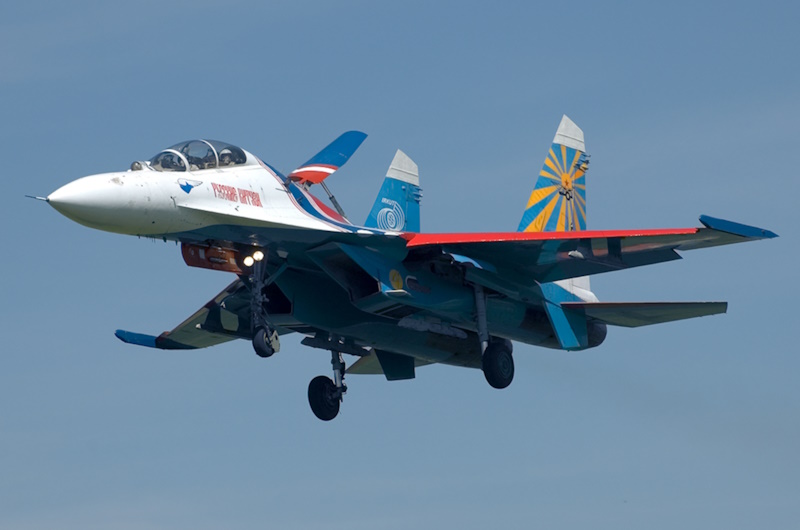
The second seat was accommodated by stretching the fuselage, with the tailfins raised in height slightly to compensate for the changed aerodynamics. The Su-27UB was fully combat-capable. Addition of the second seat increased the weight of the aircraft by only about 1,120 kilograms (2,470 pounds) without reduction in fuel capacity, and aside from minor increases in runway requirement and comparably minor decreases in top speed, the Su-27UB's performance was very similar to that of the single-seat Su-27S. Like the single-seat Su-27S, early production Su-27UBs lacked some systems and features of late-production aircraft.
* The late-production single-seat Su-27S was used as the basis for the export variant, the "Su-27SK" (where "SK" stood for "Series Kommercial"). While the Su-27SK was externally all but identical to the Su-27S, it had a downgraded radar, countermeasures, and IFF fit. A two-seat "Su-27UBK" was also built for the export market.
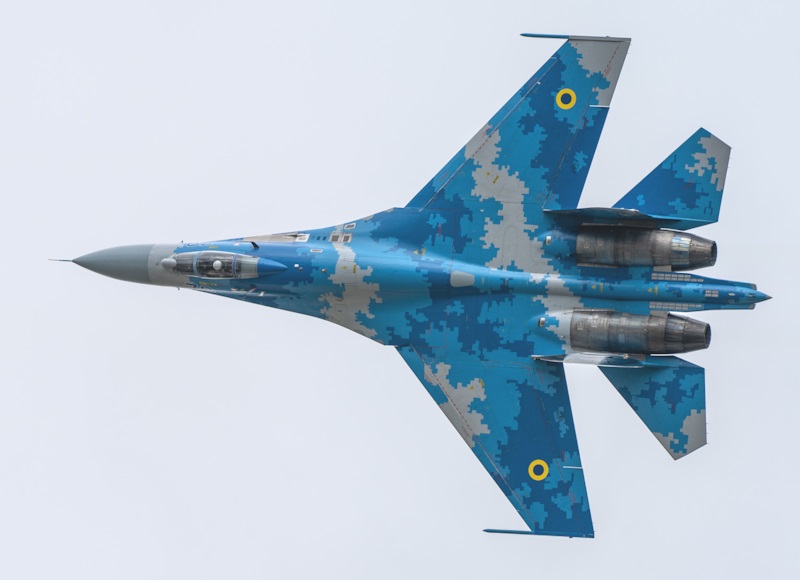
The Chinese were the first export customer for the Su-27, signing a contract in 1991 for 18 Su-27SK and 6 Su-27UBK machines, with initial deliveries in 1992. As discussed in the next chapter, they would obtain more Su-27s and obtain a license agreement, to gradually make the type their own.
Vietnam, not to be outdone by their long-standing Chinese rival, also obtained five Su-27SKs and one Su-27UBK in 1995, followed by an order for two Su-27SKs and four Su-27UBKs in 1996, with delivery of the second batch completed in the summer of 1998.
* Of course, a number of non-export Su-27S single-seaters and Su-27UB two-seaters were "inherited" by some of the newly independent states created by the collapse of the Soviet Union:
15 refurbished hand-me-down Su-27s were sold by Russia to Ethiopia beginning in the late 1990s, and apparently old Su-27s have also found their way from to Angola, Eritrea, Indonesia, and Syria. It appears two were sold by Ukraine to Air USA, a US combat training firm. Details of these deals tend to be fuzzy and contradictory.
From early in the 21st century, a number of Su-27S and Su-27UB machines were given modernizations as "Su-27SM" and "Su-27UBM" respectively. Similarly, some Su-27SK machines were updated as "Su-27SKM"; it doesn't appear there were any such updates of Su-27UBK machines. These were modest upgrades, primarily to provide multirole operation, with enhanced ground-attack capabilities. As discussed later, they were followed by more ambitious upgrades.
BACK_TO_TOP* The Red Navy had planned to acquire four fleet aircraft carriers, and so accordingly planned to build navalized versions of the MiG-29 and Su-27 for carrier operations.
Work on a navalized Su-27 actually went back almost to the very origins of the Su-27. T10S prototypes were modified to test features of navalized variants in an incremental fashion. The first test flights, from a dummy land-based carrier deck at Saki in the Crimea, featured aircraft fitted with small canard wings for better low-speed approach handling, improved short take-off performance, and enhanced combat maneuverability. Tests then went on to aircraft fitted with arresting gear, and then to tests of aircraft with carrier landing systems.
The carriers were to be fitted with "ski jump" take-off ramps instead of catapults; one of these navalized Su-27 prototypes made an initial take-off from a land-based ski jump in August 1982. In operational practice, an Su-27 was to take off a carrier deck by building up full thrust against a tilt-up blast deflector panel, until the aircraft sheared restraints holding it down to the deck. The fighter would then accelerate up the deck, hit the ski jump, and bound into the air. This unusual scheme was devised because the Soviets had no experience in building aircraft carrier catapults, and didn't want to delay introduction of the carriers while puzzling around with a new and demanding technology.
These modified prototypes led to specific prototypes for the navalized aircraft, designated "T10K". The T10Ks had canards, an arresting hook, and carrier landing systems, as well as a retractable inflight refueling probe to allow the aircraft to take off with a reduced fuel load and top off in flight. However, they did not have the ruggedized landing gear required for carrier landings and lacked folding wings. Pugachev flew the first T10K in August 1987, though that particular aircraft was lost in a mishap in 1988.
The production navalized "Su-27K" featured the required heavier landing gear, with a long two-wheel nose gear assembly, and folding wings, with drooping outer ailerons and inner double slotted flaps for low-speed carrier approaches. It had software updates relative to the Su-27, and featured a carrier landing system. The Su-27K began carrier trials on board the carrier TBILISI in November 1989, again with Pugachev at the controls, leading to introduction to formal carrier operations in September 1991.
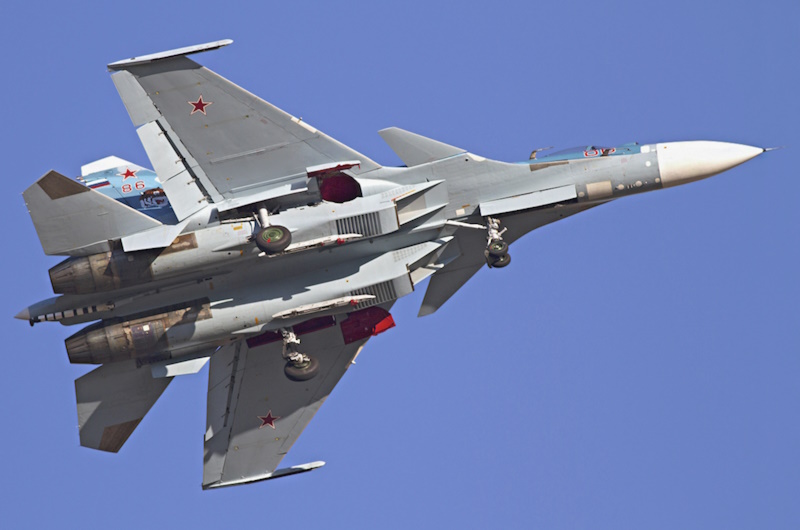
A total of 26 Su-27Ks was in service by the early 1990s, with two of them upgraded from prototypes. Abandonment of plans for the four-carrier force in the aftermath of the collapse of the USSR meant that the need for building more Su-27Ks vanished. The KUZNETZOV, as the TBILISI had been renamed after the end of the Soviet Union, made a cruise in the Mediterranean in 1996, giving the Su-27K its first taste of ocean operations. NATO assigned the Su-27K the reporting name "Flanker-D", while the Sukhoi OKB called the aircraft the "Su-33" -- this last designation not getting much use. The Sukhoi organization would not pursue carrier-based fighters further. The Su-27Ks have received modest upgrades in the 21st century and remain in service.
BACK_TO_TOP